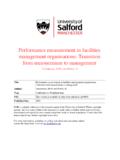Transcription of Nursing Observation and Assessment of Patients in the ...
1 1 Nursing Observation and Assessment of Patients in the Acute Medical Unit DEBORAH ATKINSON School of Nursing , Midwifery & Social Work College of Health & Social Care University of Salford, Salford, United Kingdom Submitted in partial fulfilment of the requirements of the degree of Professional Doctorate March 2013 2 Table of Contents Page Acknowledgements 6 Abstract 7 Glossary of terms 8 Chapters 1 Introduction and research purpose 9 Context for the research 11 Personal and professional motivations for the research 13 Structure of the thesis 14 Subject of the research investigation 15 Origins of acute medicine in the United Kingdom 16 The drive to improve patient outcomes.
2 The historical 19 perspective Purpose of the acute medical unit 21 Nursing in the acute medical unit 24 Conclusion 31 2 Literature Review 33 The development of early warning score Observation tools 34 Limitations of early warning scores 37 Assessment of the critically ill patient in hospital 40 Clinical decision making 43 The information processing model 48 3 The intuitive model 51 Tacit knowledge 55 Explicit knowledge 57 Nursing Observation and Assessment of the acutely ill 57 patient in hospital Search strategy 58 Inclusion and exclusion criteria 59 Results of the literature search 59 Quality appraisal of included studies 60 Review of included studies 61 Conclusion and research question 82 3 Methods and Methodology 86 Aims and objectives 87 Philosophical rationale underpinning the research 87 research design 93 Setting for the Study 96 Sampling Method 96 Identification of participants 105 Ethical considerations 106
3 research governance 110 Methodological rigour 112 Data collection 114 Participant Observation 115 Qualitative interview 121 In the field 124 4 4 Data Management and the Process of Thematic Analysis 138 Data management 140 Immersion in the data 143 Themes identified from the data 150 5 Presentation of Findings 152 Nursing Observation and Assessment of the patient in the AMU 153 Visual Assessment of the patient 154 Assessment of the patient using verbal communication 162 Monitoring the patient 168 Knowing the patient in the AMU 174 Sense of knowing 175 Gathering information 181 Impact of the AMU environment on patient Observation and 187 Assessment Managing complex care in the AMU 194 Limitations 204 6 Discussion and research contribution 206 Conclusions and recommendations for practice 222 References 232 List of Appendices: Appendix i: Example of an Early Warning Score chart 252 Appendix ii.
4 National research Ethics Committee approval 253 5 Appendix iii: NHS Site specific approval letter 255 Appendix iv University of Salford ethics committee approval 257 Appendix v Consent form 258 Appendix vi Participant information Part 1 259 Appendix vii Participant information Part 2 261 Appendix viii Levels of Care Intensive Care Society (2009) 263 Appendix ix National Early Warning Score tool 265 Appendix x Diagram to show cyclical interview method 266 List of Tables: Table 1 Summary of identified studies from the literature 62 Table 2 Participant demographics and summary of 107 Observation periods Table 3 Examples of data presentation, analysis and relation 145 to theme Table 4 Examples of data presentation, analysis and relation 146 to theme Table 5 Examples of data presentation, analysis and relation 147 to theme Table 6 Examples of data presentation, analysis and relation 148 to theme List of Figures: Figure 1 Ward layout.
5 Acute Medical Unit Male 102 Figure 2 Ward layout: Acute Medical Unit Female 103 Figure 3 Selecting among theme identification techniques 142 6 Acknowledgements My career in Nursing has spanned more than twenty-five years. I have been inspired by some of the incredibly talented and dedicated nurses that I met during that time. In times of adversity, inspiration is critical for nurses to continue to deliver the very best care that they can, and I am thankful to have met and been inspired by those individuals. I would like to thank my husband, daughters and family for their incredible support over the last seven years.
6 Also, thanks to my friends and colleagues who have continued to encourage me in this pursuit. To my supervisors, Dr Elaine Ball, Mrs Karen Holland and Dr Debbie Roberts who have offered advice, critique and words of wisdom to refine the thesis, I cannot thank you enough for the time and effort that you have given to me in this endeavour. 7 Abstract Title: Nursing Observation and Assessment of Patients in the Acute Medical Unit Objectives: To generate knowledge and understanding of the Observation and Assessment of Patients in the acute medical unit, where patient acuity and activity is unpredictable and length of stay for Patients is brief.
7 Background: Time and temporality pose challenges for the Nursing Observation and Assessment of Patients because unlike other hospital wards, the acute medical unit is a dedicated acute short-stay facility, admitting Patients with highly complex medical illness on a 24-hour basis. Over the past fifteen years, political drivers for improved efficiency of hospital beds, combined with recent austerity measures, have resulted in shorter length of stay in hospital for Patients . The implications of these for Nursing practice and the Observation of Patients have not previously been investigated. Method: An ethnographic approach was applied to explore the Nursing Observation and Assessment of Patients admitted to an acute medical unit.
8 Data were collected from seven nurse participants using participant Observation and qualitative interviews over a six-month period. A thematic analysis was undertaken. Results: The brevity of nurse-patient relationships combined with a problematic ward layout resulted in adaptations to practice to ensure safe monitoring of Patients , including frequent visual and verbal assessments of Patients . Nurses observed for facial colour, expression, appearance and verbal response. Nurses employed explicit, tacit and intuitive knowledge to interpret observations of Patients and safely managed highly complex care despite the challenge of limited time.
9 Nurses demonstrated expertise despite having limited experience. Recommendations: Layout of the acute medical unit must consider ease of visibility for patient Observation and impact upon Nursing workload. Recognition of nurses' ability to safely observe Patients is essential, rather than relying upon the use of paper-based Observation tools. Acute medical Nursing must be recognised as a distinct specialism, with appropriate standardisation. 8 Glossary of terms UKGCE United Kingdom council for graduate education AMU Acute medical unit MAU Medical Assessment unit HCA Health care assistant DH Department of health RCP Royal College of Physicians RCN Royal College of Nursing NMC Nursing and Midwifery Council UKCC United Kingdom Central Council PhD Doctor of Philosophy DProf Professional doctorate HSMR Hospital standardised mortality rate NICE National institute for health and clinical excellence NPSA National patient safety agency NCEPOD National confidential enquiry into patient outcome and death EWS Early warning score iras integrated research
10 Application system NRES National research ethics service NIPPV/NIV Non invasive positive pressure ventilation CPAP Continuous positive airways pressure BP Blood pressure CDM Clinical decision making ECG Electrocardiograph ICU Intensive care unit HDU High dependency unit ABG Arterial blood gas 9 Chapter 1 Introduction and research Purpose Patients admitted into hospital as a medical emergency are at risk of deterioration in their clinical condition due to their altered physiological state. The majority of acute illnesses develop gradually over many hours and are associated with the early presence of abnormal vital signs in the patient.












